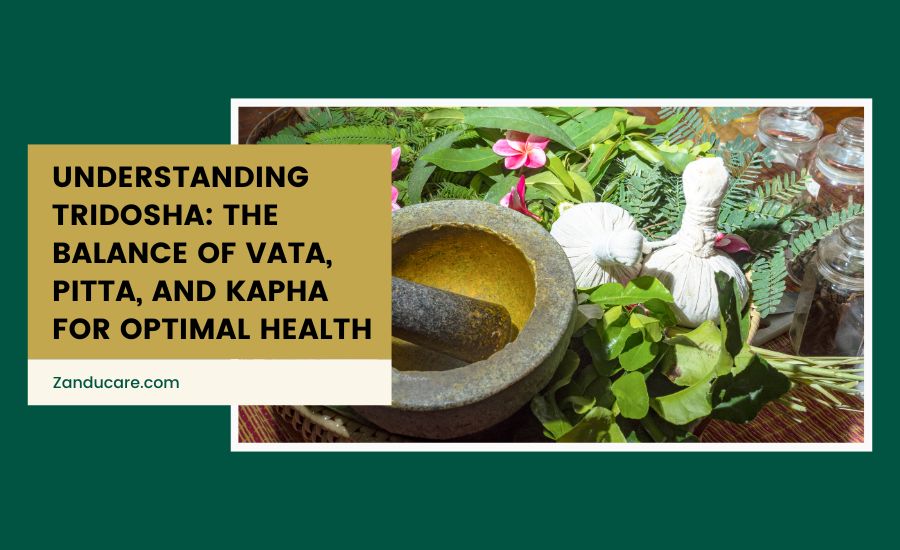|
Key insights:
- Vata, Pitta, and Kapha—your body’s unique energy blueprint—hold the key to optimal physical and mental well-being.
- Each dosha requires specific diets and herbs: warm foods for Vata, cooling remedies for Pitta, and light, energising meals for Kapha.
- Herbs like ashwagandha for Vata, amla for Pitta, and turmeric for Kapha naturally restore balance and vitality.
- Balance your doshas with yoga, aromatherapy, detoxes, and mindful living tailored to your dominant energy.
- Mastering your doshas aligns your body, mind, and emotions, leading to a happier, healthier, and more fulfilled life.
|
Ayurveda, an ancient Indian system of medicine, is based on the principle of balancing the body, mind, and spirit to maintain optimal health. One of the core concepts in Ayurveda is Tridosha, which refers to the three fundamental energies or doshas: Vata, Pitta, and Kapha. Each dosha represents different aspects of nature and plays a unique role in maintaining health.
Understanding these doshas, how they interact, and the steps to balance them can greatly enhance your well-being. Let’s delve into what Vata, Pitta, and Kapha mean and how to balance them for better health.
|
Did You Know?
- Ayurveda’s Tridosha (Vata, Pitta, Kapha) defines your body’s unique energy balance.
- Herbs like ashwagandha, amla, and turmeric help restore harmony.
- Tailored diets, yoga, and detoxes balance doshas for better health.
- A balanced Tridosha aligns body, mind, and emotions for optimal well-being.
|
Ayurveda and Doshas
Ayurvedic medicine believes the world comprises five basic elements - space, water, earth, fire, and air. Different combinations of these elements comprise three energies in the body called doshas - vata, kapha, and pitta. Every person has a mix of these three doshas. This unique mix is called their Ayurvedic constitution.
Ayurvedic medicine says your health depends on your doshas staying balanced. If they get out of balance, you can get sick. An Ayurvedic practitioner helps you find your dominant dosha and what throws it off balance. Then, they advise on lifestyle, exercises, diet, and herbs to rebalance it.
Not much scientific evidence proves that the doshas and Ayurvedic constitutions are real. But Ayurvedic medicine has been practised for thousands of years in India. Supporters say more studies are needed to show if it works, not just dismiss it as false. They believe the ideas make sense based on long experience. More research could help explain the benefits people have reported.
What Does Each Dosha Look Like?
In Ayurveda, it is believed that everyone has a unique combination of Vata, Pitta, and Kapha, which determines their physical and mental characteristics. These doshas are derived from the five elements: air, space, fire, water, and earth. Each dosha has its qualities and functions:
1. Vata Dosha
The Vata dosha represents air and space, so it tends to be light, cool, dry, and changeable. People with more Vata in their constitution often have thin bones, dry skin, and hair. Moreover, they move and talk quickly. When unbalanced, Vata types may lose weight, be constipated, have weak immunity, and feel anxious.
Vata also impacts personality. Vata people are usually energetic, flexible, enthusiastic, and creative talkers. But they can also worry, feel confused, and feel overwhelmed when stressed. Their minds race, which makes it hard for them to focus or sleep.
To balance Vata, the goal is to add opposite qualities like warmth, nutrition, moisture and stability. Eating well-cooked grains, warm spices, and milk helps. Herbs like ginger add internal heat while ashwagandha nourishes. Doing yoga, meditation, and aroma and colour therapy brings stability. Detoxing removes excess Vata.
The aim is to counter Vata's light, cool, dry and mobile qualities with grounding routines. This calms both body and mind. When Vata is balanced, energy flows smoothly, and health and happiness grow.
2. Pitta Dosha
The Pitta dosha represents the elements of fire and water. Pitta types tend to feel warm and have oily skin, penetrating eyes, and sharp features. They are focused, competitive, and clear, decisive communicators. When balanced, Pittas are energetic, courageous friends.
However, too much Pitta leads to diarrhoea, rashes, and liver issues. Out of balance, Pittas get intensely angry, jealous and critical.
The focus is on cooling, nourishing and drying to calm excessive Pitta. Recommended foods include raw veggies, rice, wheat, and beans. Cooling spices like fennel and sweet herbs like shatavari offset fiery Pitta. Bitter dandelion root dries things out.
Ayurvedic Pitta programs aim to counter intensity and add opposite qualities. Massage, aromas, peaceful colours, yoga and meditation bring relaxation. Detoxes remove excess heat. This balances sharp digestion, emotions and speech to create steady, radiant energy.
3. Kapha Dosha
The Kapha dosha combines the earth and water elements. Thus, Kaphas tend to be stable, heavy, cool, and calm. They have solid frames, smooth skin, and low energy needs. However, excess Kapha causes mucus, weight gain, and diabetes.
Kaphas handles stress well and has a steady personality. They resist change and can get stuck in ruts, seeking too much comfort. This leads to a loss of motivation. When imbalanced, Kaphas become prone to depression and lethargy.
To balance Kapha, the goal is to introduce lightness, warmth, and dryness. The diet focuses on light grains like quinoa, warming spices like cayenne, plenty of veggies, and little nuts or dairy. Cleansing herbs like guggul removes mucus while stimulating herbs like cloves to counter heaviness.
Kapha types also benefit from aroma therapy using invigorating scents and colour therapy using bright, activating hues. Detoxing, yoga, and meditation counter inertia and boost motivation. The aim is to add movement and energy to stable, heavy Kapha. When balanced, Kaphas tap their strength and endurance.
Herbs for Tridosha
Ayurveda emphasises using natural herbs to balance the three doshas—Vata, Pitta, and Kapha. Each dosha benefits from specific herbs that help bring balance and support physical and mental well-being.
1. Vata-Balancing Herbs
Vata, the dosha connected to air and space, is known for its cold, dry, and mobile qualities. Warming, calming, and nourishing herbs help balance Vata.
-
Ashwagandha: This adaptogenic herb is known for its rejuvenating properties. It supports the nervous system, reduces stress and anxiety, and enhances stamina and energy levels. Ashwagandha’s warming nature helps counter Vata's cold and airy qualities.
-
Ginger: A common household herb, ginger is warming and stimulating, which helps improve digestion and circulation. It reduces bloating and supports gut health, counteracting Vata’s tendency to cause digestive issues.
-
Licorice Root: This sweet and nourishing herb soothes the body and supports the adrenal glands. It calms the mind, helps maintain energy levels, and balances the dryness associated with Vata.
2. Pitta-Balancing Herbs
Pitta, associated with fire and water, is hot, sharp, and intense. Cooling, calming, and anti-inflammatory herbs are ideal for balancing Pitta.
-
Amla (Indian Gooseberry): Rich in vitamin C and antioxidants, amla is a powerful cooling herb. It supports digestion, enhances immunity, and reduces heat in the body, making it perfect for calming Pitta’s fiery nature.
-
Coriander: This cooling herb helps reduce internal heat and inflammation. It supports healthy liver function and promotes digestion without adding heat, making it suitable for soothing Pitta imbalances.
-
Shatavari: Known as a rejuvenating herb, Shatavari helps balance hormones, reduces inflammation, and nourishes the body. Its cooling properties are beneficial for calming Pitta and supporting reproductive health.
3. Kapha-Balancing Herbs
Kapha, connected to earth and water, is heavy, slow, and moist. Warming, stimulating, and light herbs help balance Kapha.
-
Turmeric: This golden spice is celebrated for its anti-inflammatory and antioxidant properties. It stimulates digestion, boosts metabolism, and clears mucus, helping to counteract Kapha’s heavy and sluggish nature.
-
Black Pepper: Known for enhancing digestion and boosting metabolism, black pepper stimulates the digestive fire (Agni) and reduces congestion and excess mucus in the body.
-
Trikatu: A traditional Ayurvedic blend of three warming spices—ginger, black pepper, and long pepper (pippali). Trikatu stimulates digestion, clears congestion, and invigorates Kapha, promoting energy and metabolic function.
Diet for Tridosha
Here’s the diet for each dosha:
|
Dosha
|
Diet Do's
|
Diet Don'ts
|
|
Vata
|
- Eat warm, cooked foods like soups, stews, and porridge.
- Include healthy fats such as ghee and olive oil for lubrication.
- Favor sweet, sour, and salty tastes.
- Drink warm teas with spices like ginger and cinnamon.
- Snack on moist and easily digestible foods like bananas and avocados.
|
- Avoid raw, cold, and dry foods (e.g., salads, crackers).
- Limit stimulants such as caffeine and alcohol.
- Steer clear of bitter, astringent, and overly spicy flavours.
- Reduce consumption of carbonated drinks and cold beverages.
|
|
Pitta
|
- Focus on cooling foods such as cucumbers, leafy greens, and coconut water.
- Choose sweet, bitter, and astringent tastes.
- Incorporate dairy products like milk and yoghurt in moderation.
- Use cooling herbs like cilantro and fennel in your meals.
- Eat fresh, unprocessed foods.
|
- Avoid hot, spicy, and oily foods (e.g., chillies, fried snacks).
- Limit acidic foods like tomatoes, citrus fruits, and vinegar.
- Reduce alcohol and caffeine consumption.
- Stay away from overly salty or fermented items.
- Cut back on excessive garlic and onions.
|
|
Kapha
|
- Opt for light, dry, and warm foods like grilled vegetables and legumes.
- Embrace bitter, pungent, and astringent tastes.
- Include spices like turmeric, black pepper, and ginger.
- Eat plenty of vegetables, especially leafy greens.
- Drink warm teas such as green tea or spiced herbal teas.
|
- Avoid heavy, oily, and cold foods like dairy, fried items, and rich desserts.
- Limit sweet and salty foods.
- Steer clear of excessive bread and red meat.
- Reduce sugar and cold drinks.
- Avoid overeating and large meals.
|
Conclusion
Achieving balance in Vata, Pitta, and Kapha is not about making drastic changes overnight but incorporating small, mindful adjustments into your daily routine. Regularly assess your feelings and adjust your diet, lifestyle, and self-care practices. By understanding the unique qualities of Vata, Pitta, and Kapha, you can maintain a balanced life that supports your physical, mental, and emotional health.
FAQs
1. How do you balance Vata Pitta and Kapha?
Warm, grounding foods like cooked grains and root vegetables are ideal for Vata persons. In addition, fruits and vegetables are cooling foods Pitta people should consume. People who are Kapha should eat foods that are light and easy to digest. Lifestyle choices can also affect how well your dosha is balanced.
2. How do you balance all three doshas in your body?
Your diet plays a key role in both causing and correcting imbalances. Acidic, bitter, and astringent flavours bring everything back into balance. These include quinoa, tofu, beans, lentils, pomegranates, gourds, bitter melon, fenugreek, turmeric, and apples.
3. Which Mudra balances all 3 doshas?
According to Ayurveda, Apana mudra helps balance the three doshas in the human body by increasing the Vata and Kapha doshas and decreasing the Pitta dosha. Thus, those with Vata and Kapha constitutions should use this mudra sparingly.
4. What happens if kapha is high?
Kapha is composed of grounding and stability, structure and cohesion, and the energy of water and earth. This dosha controls our capacity for growth, sustenance, lubrication, endurance, and contentment. Overconsumption can result in fatigue, a lack of drive, mental and physical heaviness, and excessive sleep.
References:
-
Ayurvedic medicine believes the world comprises five basic elements - space, water, earth, fire, and air. (https://pmc.ncbi.nlm.nih.gov)
-
Ayurvedic medicine says your health depends on your doshas staying balanced. (https://pmc.ncbi.nlm.nih.gov)
-
Diet for Tridosha (https://pmc.ncbi.nlm.nih.gov)











